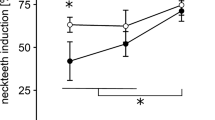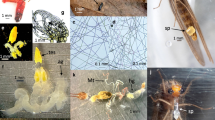Abstract
The micro-crustacean Daphnia pulex is a model species for studying predator-induced defenses. When exposed to chemical cues released by its predator, the phantom midge larvae Chaoborus (Diptera), it develops protective neckteeth that reduce the predator’s success of predation in the juvenile instars. Defensive traits need to be expressed as soon as possible, which requires an early sensitivity to predator cues. We investigated the exact kairomone-sensitive period in three D. pulex strains and the timeline of neckteeth expression in early juvenile instars. We divided embryonic development into five major stages based on successive morphological landmarks. We exposed animals in these developmental stages to kairomones in order to determine the sensitive periods for neckteeth expression in the 1st and 2nd juvenile instar. Our results indicate that kairomone sensitivity starts during embryogenesis when compound eye spots begin to fuse and egg membranes are shed. Neckteeth develop with a stage-dependent time lag, being shorter when exposed in the first kairomone-sensitive stage and longer when exposed in the following developmental stages. Evolution of early kairomone sensitivity and fast defense development is a crucial step in D. pulex’s defenses against Chaoborus as it allows for protection of the most vulnerable juvenile stages.







Similar content being viewed by others
References
DeWitt, T. J., 1998. Costs and limits of phenotypic plasticity: tests with predator-induced morphology and life history in a freshwater snail. Journal of Evolutionary Biology 11: 465–480.
Halcrow, K., 1976. The fine structure of the carapace integument of Daphnia magna Straus (Crustacea, Branchiopoda). Cell and Tissue Research 169: 267–276.
Imai, M., Y. Naraki, S. Tochinai & T. Miura, 2009. Elaborate regulations of the predator-induced polyphenism in the water flea Daphnia pulex: kairomone-sensitive periods and life-history tradeoffs. Journal of Experimental Zoology A: Ecology Genetic and Physiology 311: 788–795.
Kotov, A. A. & O. S. Boikova, 2001. Study of the late embryogenesis of Daphnia (Anomopoda, Cladocera, Branchiopoda) and a comparison of development in Anomopoda and Ctenopoda. Hydrobiologia 442: 127–143.
Krueger, D. A. & S. I. Dodson, 1981. Embryological induction and predation ecology in Daphnia pulex. Limnology and Oceanography 26: 219–223.
Laforsch, C. & R. Tollrian, 2004. Embryological aspects of inducible morphological defenses in Daphnia. Journal of Morphology 262: 701–707.
Naraki, Y., C. Hiruta & S. Tochinai, 2013. Identification of the precise kairomone-sensitive period and histological characterization of necktooth formation in predator-induced polyphenism in Daphnia pulex. Zoological Science 30: 619–625.
Siegel, S. & N. J. Castellan, 1988. Nonparametric statistics for the behavioral sciences. McGraw-Hill, New York.
Tollrian, R., 1993. Neckteeth formation in Daphnia pulex as an example of continuous phenotypic plasticity: morphological effects of Chaoborus kairomone concentration and their quantification. Journal of Plankton Research 15: 1309–1318.
Tollrian, R., 1995a. Chaoborus crystallinus predation on Daphnia pulex: can induced morphological changes balance effects of body size on vulnerability? Oecologia 101: 151–155.
Tollrian, R., 1995b. Predator-Induced morphological defenses: costs, life history shifts, and maternal effects in Daphnia pulex. Ecology 76: 1691–1705.
Tollrian, R. & C. D. Harvell, 1999. The ecology and evolution of inducible defenses. Princeton University Press, Princeton, N.J.
Tollrian, R. & S. D. Dodson, 1999. Inducible defenses in cladocera: constraints, costs and multipredator environments. In Tollrian, R. & D. Harvell (eds), The ecology and evolution of Inducible Defenses. Princeton University Press, Princeton: 177–202.
Waddington, C. H., 1942. Canalization of development and the inheritance of acquired characters. Nature 150: 563–565.
Weiss, L. C., S. Kruppert, C. Laforsch & R. Tollrian, 2012. Chaoborus and Gasterosteus anti-predator responses in Daphnia pulex are mediated by independent cholinergic and gabaergic neuronal signals. PloS One 7(5): e36879.
Weiss, L. C., J. Leimann & R. Tollrian, 2015. Predator-induced defenses in Daphnia longicephala: location of kairomone receptors and timeline of sensitive phases to trait formation. The Journal of Experimental Biology 218: 2918–2926.
Acknowledgments
We thank Thomas White for proof reading of the English language.
Funding
Linda C. Weiss was funded by the Leopoldina—National Academy of Sciences, Germany.
Author information
Authors and Affiliations
Corresponding author
Ethics declarations
Conflict of Interest
The authors declare that they have no conflict of interest.
Additional information
Handling editor: Piet Spaak
Electronic supplementary material
Below is the link to the electronic supplementary material.
Rights and permissions
About this article
Cite this article
Weiss, L.C., Heilgenberg, E., Deussen, L. et al. Onset of kairomone sensitivity and the development of inducible morphological defenses in Daphnia pulex . Hydrobiologia 779, 135–145 (2016). https://doi.org/10.1007/s10750-016-2809-4
Received:
Revised:
Accepted:
Published:
Issue Date:
DOI: https://doi.org/10.1007/s10750-016-2809-4




